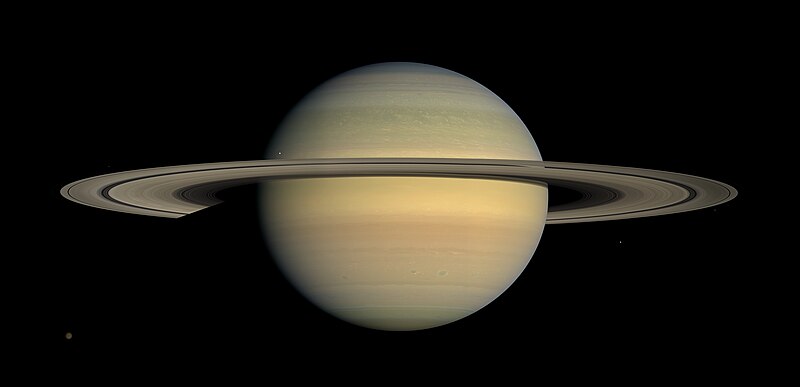Saturn, the sixth planet from the Sun and the second-largest in our Solar System, comes after Jupiter in size. This gas giant boasts an average radius about nine-and-a-half times that of Earth. While having only one-eighth the average density of our planet, Saturn is remarkably over 95 times more massive. Despite being nearly as large as Jupiter, Saturn holds less than one-third of Jupiter’s mass. It completes its orbit around the Sun at a distance of 9.59 astronomical units (1,434 million km) and takes approximately 29.45 years to complete one full orbit.

Gravity: 10.44 m/s²
Orbital Period: 10,755.7 Earth days
Length of Day: 0d 10h 34m
Radius: 58,232 km
Distance from Sun: 1.4529 billion km
Coordinates: RA 22h 44m 54s | Dec -9° 40′ 26″
Moons: There are 146 moons with confirmed orbits, the most of any planet in the solar system. This number does not include the many thousands of moonlets embedded within Saturn’s dense rings, nor hundreds of possible kilometer-sized distant moons that were seen through telescopes but not recaptured.
This is a video of me exploring the 3D Model that NASA provides! I really wanted to capture Saturn’s beautiful rings (that make Saturn, Saturn!), and the number of moons that surround the planet!
Size and Distance
Saturn has a diameter of 36,183.7 miles (58,232 kilometers), making it nine times larger than Earth. To put it in perspective, if Earth were the size of a nickel, Saturn would be comparable to a volleyball in size.
Situated at an average distance of 886 million miles (1.4 billion kilometers) from the Sun, Saturn is positioned 9.5 astronomical units away. An astronomical unit (AU) is the distance from the Sun to Earth. At this distance, it takes sunlight a duration of 80 minutes to journey from the Sun to Saturn.
Orbit and Rotation
Saturn holds the title of having the second-shortest day in our solar system. A single rotation, or a day on Saturn, lasts a mere 10.7 hours. In terms of its orbital journey around the Sun, equivalent to a Saturnian year, the planet completes this circuit in approximately 29.4 Earth years, corresponding to 10,756 Earth days.
With its axis tilted by 26.73 degrees concerning its orbit around the Sun—similar to Earth’s 23.5-degree tilt—Saturn, like our home planet, undergoes seasonal variations.
Rings
The rings of Saturn are believed to consist of remnants from comets, asteroids, or fragmented moons that disintegrated before reaching the planet, succumbing to the formidable gravitational forces of Saturn. Comprising billions of small fragments composed of ice and rock, these particles are often coated with various materials, including dust. Spanning from minuscule, dust-sized icy grains to chunks comparable in size to houses and even mountains, the ring particles exhibit a diverse range of sizes. If viewed from the cloud tops of Saturn, the rings would predominantly appear white. Notably, each ring follows a distinct orbital speed around the planet.
https://science.nasa.gov/saturn/facts/
